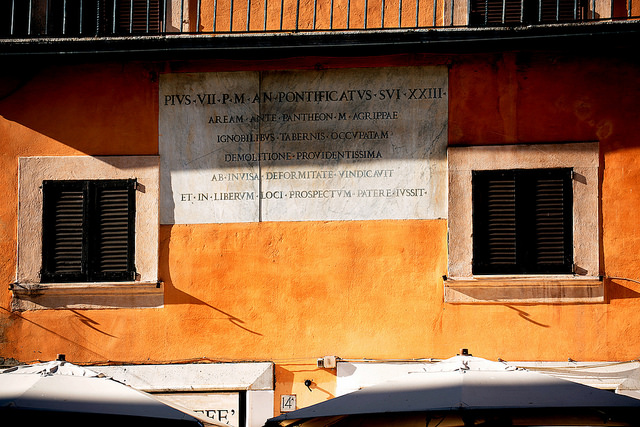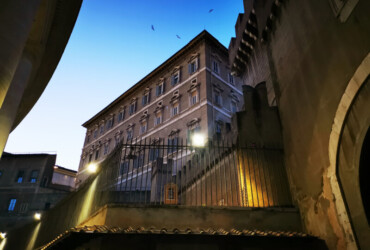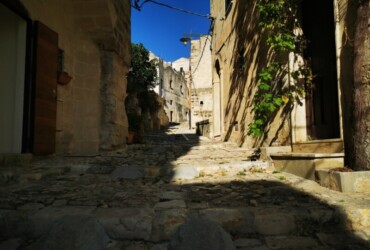Would you like to go for a walk through Secret Rome, to discover its unusual and little-known stories? So let’s go for a walk around the historic centre, from the Tiber island up to the octopus pacis, to discover a secret Rome. What do you know about the legend of Aesculapius and the snake that jumped into the Tiber at the height of where is now the Tiber Island? In the III century a.C. in Rome, there was a terrible pestilence, and the Romans decided to send a delegation to Greece to ask for help in Aesculapius, the god of
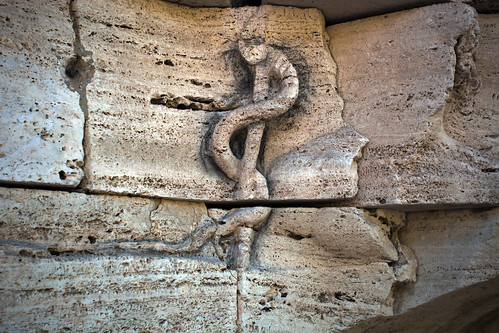 medicine. The legend tells that a snake was introduced on the ship and the sages interpreted the event as a divine sign, leaving for Rome with the snake on the boat. It’s said that, at the height of the Tiber Island, the snake threw itself into the Tiber and no one ever found it: this was interpreted as a sign, and the Romans built a temple at Esculapio exactly where the snake had indicated throwing himself into the water. The legend tells, finally, that shortly after the erection of the temple dedicated to Aesculapius (on the Tiber Island) the epidemic ceased: the island is, still today, devoted to the care of the sick, thanks to the Fatebenefratelli hospital. Where once stood the ancient temple, today is the Basilica of San Bartolomeo. The memory of the snake is carved in the stone of the island, at the height of the ship stern.
medicine. The legend tells that a snake was introduced on the ship and the sages interpreted the event as a divine sign, leaving for Rome with the snake on the boat. It’s said that, at the height of the Tiber Island, the snake threw itself into the Tiber and no one ever found it: this was interpreted as a sign, and the Romans built a temple at Esculapio exactly where the snake had indicated throwing himself into the water. The legend tells, finally, that shortly after the erection of the temple dedicated to Aesculapius (on the Tiber Island) the epidemic ceased: the island is, still today, devoted to the care of the sick, thanks to the Fatebenefratelli hospital. Where once stood the ancient temple, today is the Basilica of San Bartolomeo. The memory of the snake is carved in the stone of the island, at the height of the ship stern.
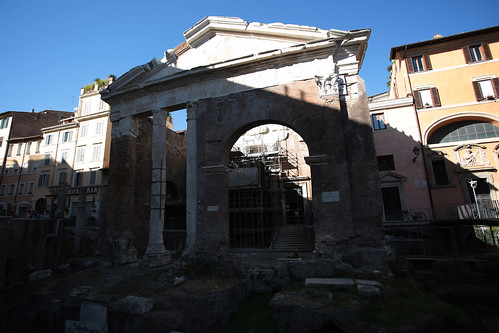 The ghetto of Rome is an area of the city that tells a lot of stories, and the more they listen to it, the more it turns out there is to be heard. Between the Middle Ages and the beginning of the 800, the area of the Portico d’Ottavia housed what was called the Roman Pescheria. In memory remains, on the facade of the church of Sant’Angelo in Pescheria, a marble plaque that establishes the measures of the fish. In addition to that, this plate also served to communicate that the conservatives (civil administrators) had the right to take the heads of the fish longer than thirteen centimetres. It is also specified that no one could say that he didn’t know the rule, which had to be respected without delays (one couldn’t even appeal to the good faith of the person in front of him).
The ghetto of Rome is an area of the city that tells a lot of stories, and the more they listen to it, the more it turns out there is to be heard. Between the Middle Ages and the beginning of the 800, the area of the Portico d’Ottavia housed what was called the Roman Pescheria. In memory remains, on the facade of the church of Sant’Angelo in Pescheria, a marble plaque that establishes the measures of the fish. In addition to that, this plate also served to communicate that the conservatives (civil administrators) had the right to take the heads of the fish longer than thirteen centimetres. It is also specified that no one could say that he didn’t know the rule, which had to be respected without delays (one couldn’t even appeal to the good faith of the person in front of him).
 Let’s go ahead and move to the Pantheon and the crowded square of the roundabout. The square is one of the most famous in Rome, but, probably, very few have ever noticed the plaque against the “ignoble taverns and their ugly ugliness”. Already at the time of Pius VII, the square was crowded with restaurants, and the pope had this plaque affixed to justify their demolition with what is called “odious ugliness”. I must say that in many years I had never noticed it and I had to pay close attention to find it!
Let’s go ahead and move to the Pantheon and the crowded square of the roundabout. The square is one of the most famous in Rome, but, probably, very few have ever noticed the plaque against the “ignoble taverns and their ugly ugliness”. Already at the time of Pius VII, the square was crowded with restaurants, and the pope had this plaque affixed to justify their demolition with what is called “odious ugliness”. I must say that in many years I had never noticed it and I had to pay close attention to find it!
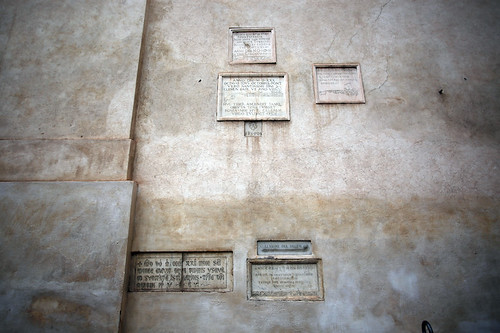 Not far from the square is the church of Santa Maria Sopra Minerva, on whose façade there are the Tiber flood plaques. These plates mark the level reached by the river water during various floods. There are many, at different heights because the church is in one of the lowest points of the city, where the water reached very high heights compared to many other places in the rest of the town. But how did the water come up here, since we are not however near the river? Simple: the water went up the Cloaca Maxima, the ancient system of sewers in Rome! The floods in Rome were widespread because during the rainy season the level of the Tiber rose a lot (it still happens today, when there are abundant rains) and the absence of very high banks like today allowed the water of the river to get out of its course and flood the city.
Not far from the square is the church of Santa Maria Sopra Minerva, on whose façade there are the Tiber flood plaques. These plates mark the level reached by the river water during various floods. There are many, at different heights because the church is in one of the lowest points of the city, where the water reached very high heights compared to many other places in the rest of the town. But how did the water come up here, since we are not however near the river? Simple: the water went up the Cloaca Maxima, the ancient system of sewers in Rome! The floods in Rome were widespread because during the rainy season the level of the Tiber rose a lot (it still happens today, when there are abundant rains) and the absence of very high banks like today allowed the water of the river to get out of its course and flood the city.
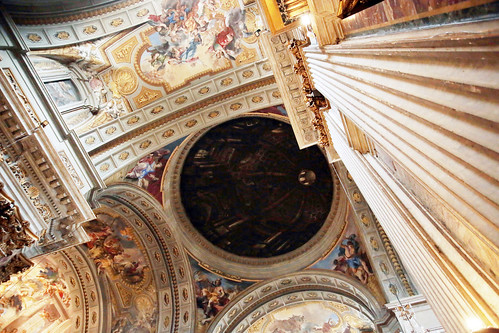 Do you know the Church of Sant’Ignazio di Loyola, in Campo Marzio? It’s located, to give you some points of reference, between Via del Corso and Piazza della Minerva and I discovered it by chance reading about its flat dome. In what sense “flat dome”? In the sense that a clever game of perspectives allows you to see the dome only from some points of the central nave of the church. Otherwise, you will see it simply as a “flat” design on the ceiling (where you should find a “real” dome). My opinion? The perspective game is
Do you know the Church of Sant’Ignazio di Loyola, in Campo Marzio? It’s located, to give you some points of reference, between Via del Corso and Piazza della Minerva and I discovered it by chance reading about its flat dome. In what sense “flat dome”? In the sense that a clever game of perspectives allows you to see the dome only from some points of the central nave of the church. Otherwise, you will see it simply as a “flat” design on the ceiling (where you should find a “real” dome). My opinion? The perspective game is
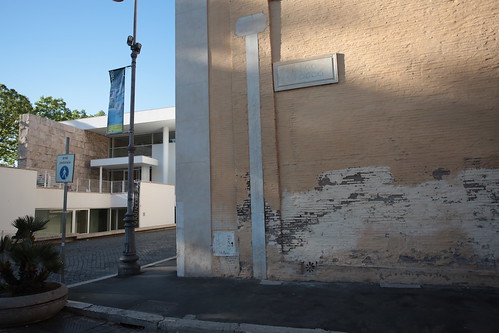 stunning! To end our tour, I will take you to discover the Ripetta ancient port. In Largo San Rocco, next to the Ara Pacis, on the wall of the church of San Rocco, there is a marble hydrometer of the port of Ripetta: there were 5 and were used to mark the height of the Tiber’s water. The highest inscription, relating to the flood of 1598, marks 19.56 meters: the strength of that flood was so big that it has broken tree arches of the Emilio bridge (now known as “The broken bridge”), making it unusable in a definitive way. The port of Ripetta was used until 1870 when there was a new Tiber flooding.
stunning! To end our tour, I will take you to discover the Ripetta ancient port. In Largo San Rocco, next to the Ara Pacis, on the wall of the church of San Rocco, there is a marble hydrometer of the port of Ripetta: there were 5 and were used to mark the height of the Tiber’s water. The highest inscription, relating to the flood of 1598, marks 19.56 meters: the strength of that flood was so big that it has broken tree arches of the Emilio bridge (now known as “The broken bridge”), making it unusable in a definitive way. The port of Ripetta was used until 1870 when there was a new Tiber flooding.
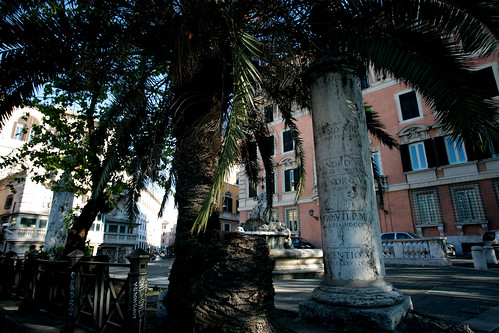 Finally, I would like to point out that in the piazza del porto di Ripetta there are two columns of the old port: in marble, next to a fountain, you can see little and are the only remains of the Porto di Ripetta. The shape is similar to that of the columns that were made in antiquity and the inscriptions that are still read make their function of hydrometers understand: the engravings report news of the main floods of the Tiber. Small historical note: the term “Ripetta” meant “small bank” and was given this name to this small port to distinguish it from the main port in “Ripa grande”, on the right bank of the river below the monumental complex of San Michele. It is not a very short ride, it must be admitted, but I believe that each of these places can best remind us of the history that runs through Rome in all its splendour!
Finally, I would like to point out that in the piazza del porto di Ripetta there are two columns of the old port: in marble, next to a fountain, you can see little and are the only remains of the Porto di Ripetta. The shape is similar to that of the columns that were made in antiquity and the inscriptions that are still read make their function of hydrometers understand: the engravings report news of the main floods of the Tiber. Small historical note: the term “Ripetta” meant “small bank” and was given this name to this small port to distinguish it from the main port in “Ripa grande”, on the right bank of the river below the monumental complex of San Michele. It is not a very short ride, it must be admitted, but I believe that each of these places can best remind us of the history that runs through Rome in all its splendour!
Secret Rome: discovering the historical centre
